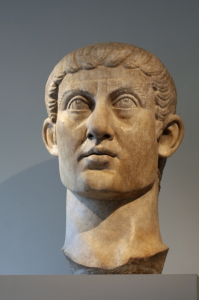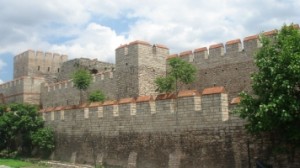 Constantine the Great: (February 27, 272 – May 22, 337), was also known as Constantine I or Saint Constantine. He was the 57th Roman Emperor and reigned as Emperor from 306 to 337. Constantine was the son of Flavius Valerius Constantius, a Roman army officer, and his consort Helena. His father became Caesar, the deputy emperor in the west in 293. Constantine was sent to eastern portion of the empire where he succeeded militarily and rose through the ranks to become a military tribune under several. In 305, his father, Constantius was raised to the rank of Augustus, the senior western emperor and Constantine was recalled west to campaign under his father in what is now the British Isles.
Constantine the Great: (February 27, 272 – May 22, 337), was also known as Constantine I or Saint Constantine. He was the 57th Roman Emperor and reigned as Emperor from 306 to 337. Constantine was the son of Flavius Valerius Constantius, a Roman army officer, and his consort Helena. His father became Caesar, the deputy emperor in the west in 293. Constantine was sent to eastern portion of the empire where he succeeded militarily and rose through the ranks to become a military tribune under several. In 305, his father, Constantius was raised to the rank of Augustus, the senior western emperor and Constantine was recalled west to campaign under his father in what is now the British Isles.
He was acclaimed as emperor by the army after his father’s death in 306, Constantine emerged victorious in a series of civil wars against several other emperors to become sole ruler of both the western and eastern empire in 324.
 As emperor, Constantine enacted many political, financial, social, and military reforms that strengthened the empire.
As emperor, Constantine enacted many political, financial, social, and military reforms that strengthened the empire.
- The government was restructured and civil and military authority separated which is key separation of powers that has been imitated in many political and governmental systems such as our own American system of government.
- A new gold coin was minted to help combat inflation. It would become the standard for Byzantine and European currencies for more than a thousand years.
- He was the first Roman emperor to convert to Christianity. He also played an influential role in the proclamation of the Edict of Milan, which decreed religious tolerance throughout the empire. This too, is a hallmark of American culture.
- He also called the First Council of Nicaea in 325, at which the Nicene Creed was drafted and was professed as part of Christian orthodoxy and teach and is still professed by Christians today.
- In military matters, the Roman army was reorganized to consist of mobile field units and garrison soldiers capable of countering internal threats and the barbarian invasions.
 The age of Constantine marked a distinct era in the history of the Roman Empire. He built a new imperial residence at Byzantium and named it New Rome. However, in Constantine’s honor, the Romans called it Constantinople, which would later be the capital of what is now known as the Byzantine Empire for over a thousand years.
The age of Constantine marked a distinct era in the history of the Roman Empire. He built a new imperial residence at Byzantium and named it New Rome. However, in Constantine’s honor, the Romans called it Constantinople, which would later be the capital of what is now known as the Byzantine Empire for over a thousand years.
Because of this, and so much more, he is thought of as the founder of the Byzantine Empire. His reputation flourished during the lifetime of his children and centuries after his reign thus creating a dynasty.
Constantine, as the first Christian emperor, is a significant figure in the history of Christianity. The Church of the Holy Sepulchre, built on his orders at the purported site of Jesus’ tomb in Jerusalem, became the Holiest place in all of Christendom. The Papacy claimed temporal power through Constantine. He is venerated as a saint by Eastern Orthodox Christians, Byzantine Catholics, and Anglicans. The Eastern churches hold his memory in particular esteem, regarding Constantine as isapostolos or equal-to-apostles.
So, on what has become known in social media as “Throwback Thursday”, I thought I would go all the way back to the 4th century for a leader worthy of “throwing back to”.
Photo credit: Foter / (CC BY-SA 2.0)
Photo credit: Foter / (CC BY-SA 2.0)
Photo credit: Foter / (CC BY-SA 3.0)
Photo credit: tim_d / Foter / (CC BY-NC-SA 2.0)



Please note: I reserve the right to delete comments that are offensive or off-topic.